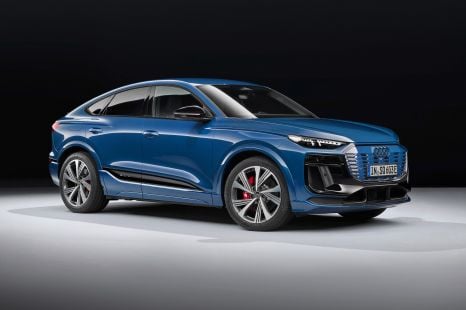

William Stopford
2026 Audi Q6 and SQ6 Sportback e-tron price and specs
3 Days Ago
This could be the sweet spot in the Lexus RX range… unless you’re after an exciting luxury SUV experience.
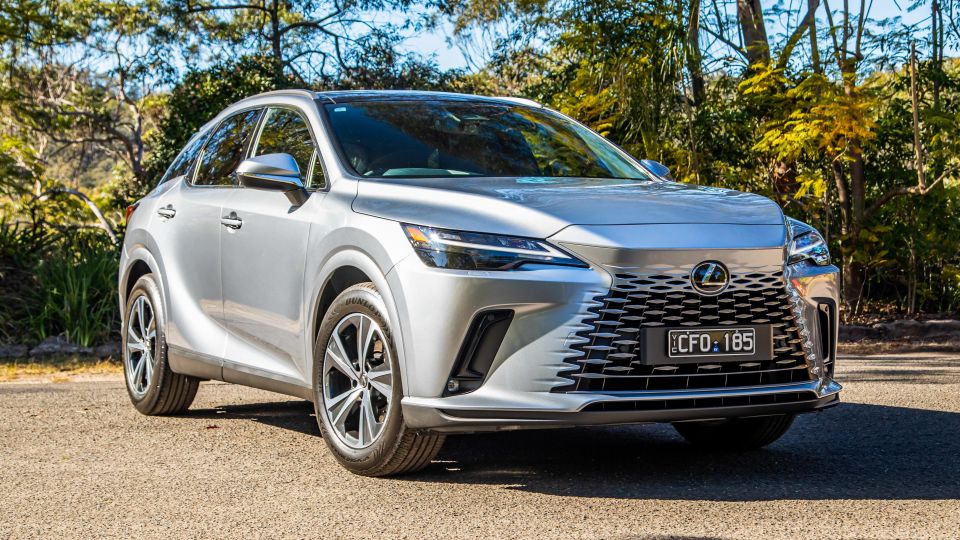


Quickly see how this car stacks up against its competition. Select any benchmark to see more details.
Where expert car reviews meet expert car buying – CarExpert gives you trusted advice, personalised service and real savings on your next new car.
The new-generation Lexus RX range has been on sale for a while now – you’ve probably seen them around if you live in one of Australia’s larger cities. In fact, you may have even seen some new-gen RX taxis!
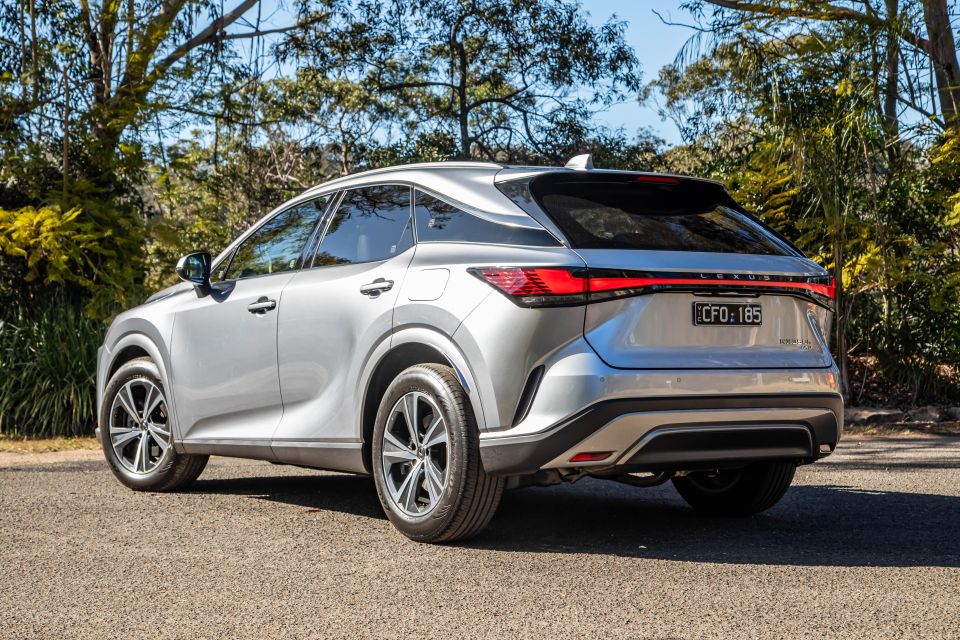
Those are invariably the RX 350h Luxury spec, which is the variant we have on test. But, specifically, this review focuses on the all-wheel drive version with the optional Enhancement Pack.
That bumps the price up from base-model levels to damn-near $100,000 before on-road costs, but I reckon this could still be the pick of the RX range.
I’ll tell you why below, and why I also reckon this might not be the ideal luxury SUV for those who fancy themselves to be a bit of a car enthusiast.
There are 14 derivations of Lexus RX in this generation, and unlike the last one, none of them are seven-seaters.
That seems excessive to me, and really, Lexus could have condensed the line-up to half that number and still arguably have met the needs of its customers.
Take the Lexus RX 350h, for instance. You can have it in front-wheel drive for $87,500, or you can make it all-wheel drive, like this one, which means a jump to $92,000 – all prices exclude on-road costs.
But then if you want a bunch of the good stuff this particular model comes with, you need to choose the Enhancement Pack, which you can have as a 2WD ($92,600) or AWD ($97,500).
So that’s four variants for one variant! Anyway, I think at $97,500 plus on-roads this grade is a great choice, and the details of what’s included as standard for that amount of money are listed down below.
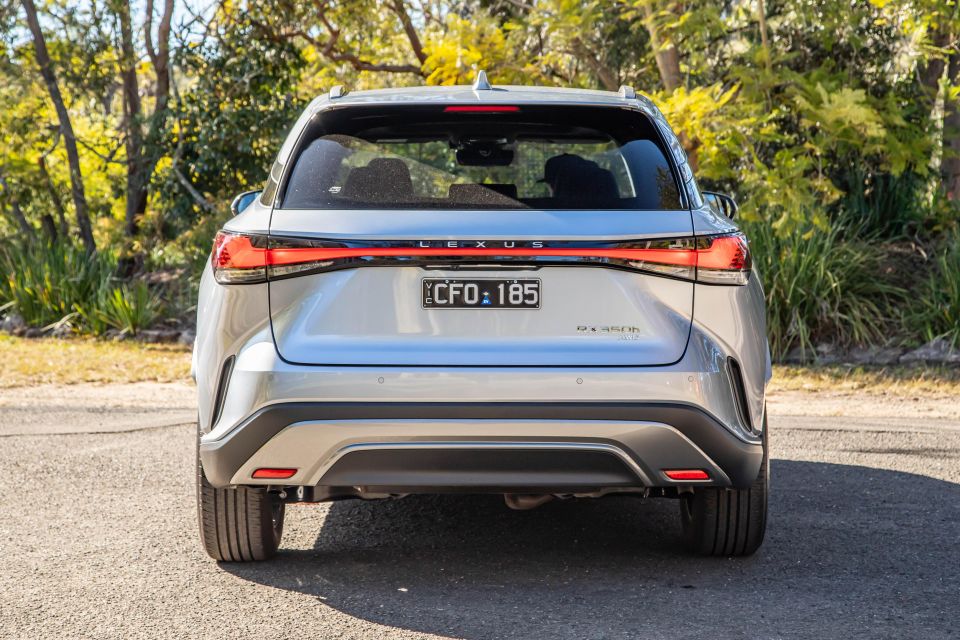
What else can you get at this price? Well, a Genesis GV80 2.5T AWD – admittedly, not hybrid – comes in at $97,200. Lots of presence and performance for the money, I reckon.
And if you are sold on something Japanese, large, and maybe a bit more exciting, then the new top-spec Mazda CX-90 six-cylinder petrol G50e Azami at $95,185 may be a cool left-field choice – plus it offers three rows.
The diesel-powered Volkswagen Touareg 170TDI (from $89,240) could also offer some food for thought. It’s a lovely rig.
Buy your new car without the stress. It's fast, simple and completely free.

Great service from Travis and team, second time I have used this business would not hesitate to recommend them to anyone
Craig C.
Purchased a Ford Ranger in Sunshine Coast, QLD
CarExpert helped Craig save $7,224 on his Ford Ranger, now let us save you on your next new car.
Get your BEST priceThe interior of the new-generation Lexus RX is certainly an improvement on the old model, but it doesn’t perhaps have as much ‘all-new’ feel to it as you might expect or hope for.
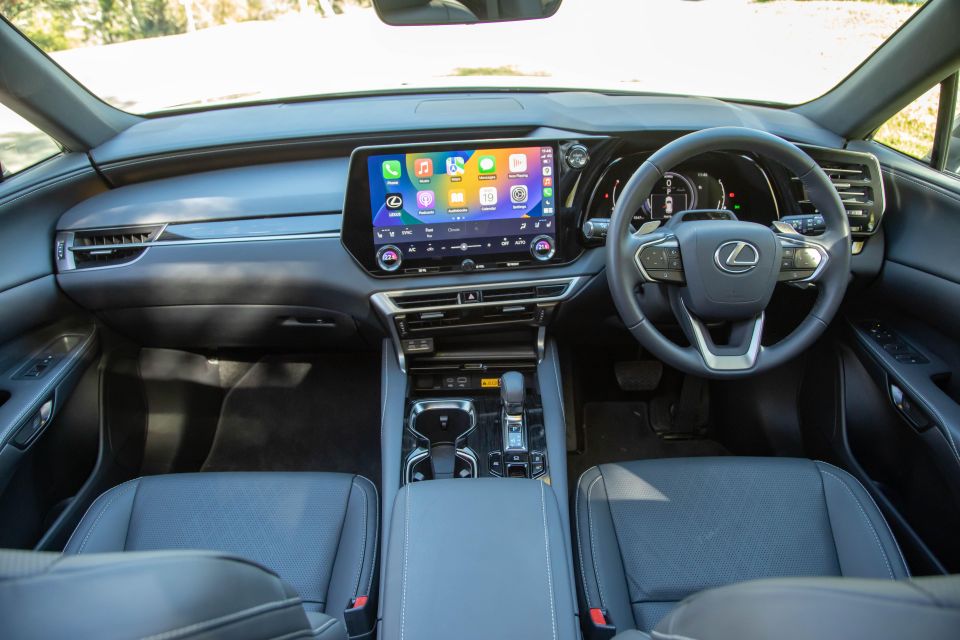
Sure, there have been big upgrades to the multimedia screen and the materials are still of a very high perceived quality, but the design is a bit predictable… but perhaps that is exactly what a Lexus RX buyer wants.
The screen is the big wow factor moment inside the cabin – it’s a standard-fit 14.0-inch touchscreen unit with wired/wireless Apple CarPlay, Android Auto and sat nav. It encompasses the expected multimedia elements, but it also acts as the control centre for the climate settings.
There are two dials at the lower edges of the screen for dual-zone climate, and between them is a ‘hard’ bar that remains on-screen at all times when operating, and it houses most of the other climate functions – fan speed, recirculating air and so on.
There are hard buttons below the screen for front and rear demisters, and a volume knob, too.
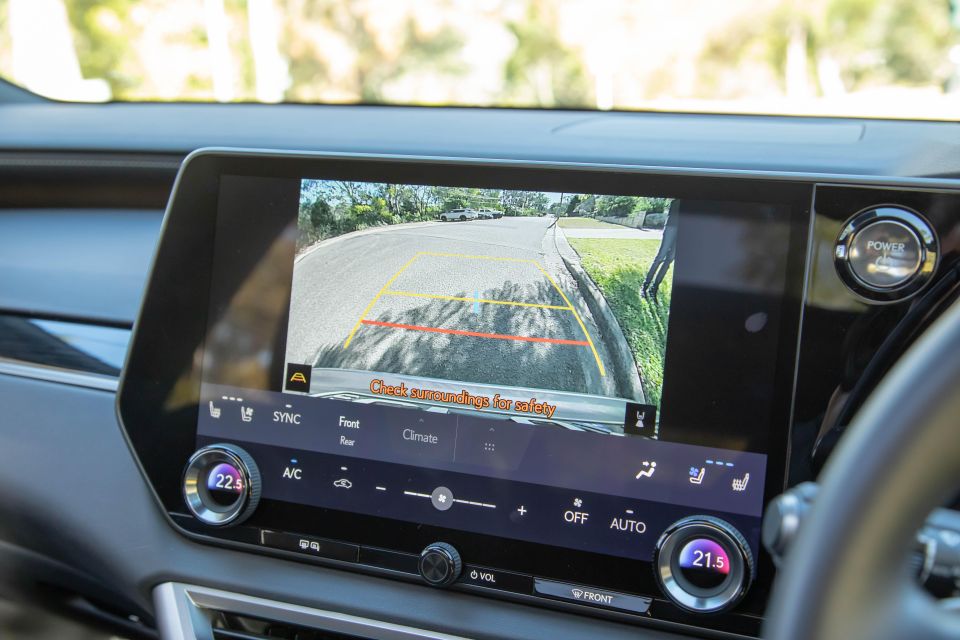
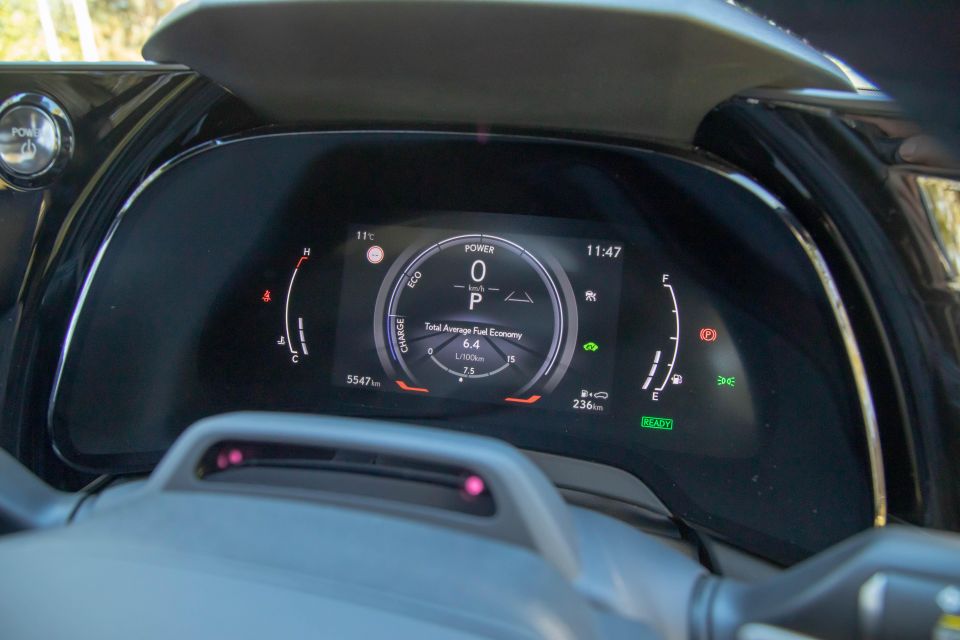
The controls are okay in most situations, but the menus upon menus do take some learning. For instance, you don’t go through the Settings>Sound menu to adjust the bass, treble and fader.
You do that by hitting the three-dots icon on the play screen when you’re listening to an audio source. And there are so many sub-menus, that you will need more than a week to get used to the interactions required with the screen. In fact, compared to some rivals, it feels a bit unfinished.
The other screen in the cabin – in front of the driver – is far less impressive. If I’m not mistaken, the display used has been around for a decade or more, and it looks old compared to the big display for media stuff. It’s low resolution and it’s small by modern standards.
In the Enhancement Pack models you also score a head-up display, which projects an array of colour (but it looks monochromatic) info on the windscreen ahead of the driver. You will rely on this more than you might expect for cruise control settings and media controls, as the touch-sensitive buttons on the steering wheel are the controllers for such.
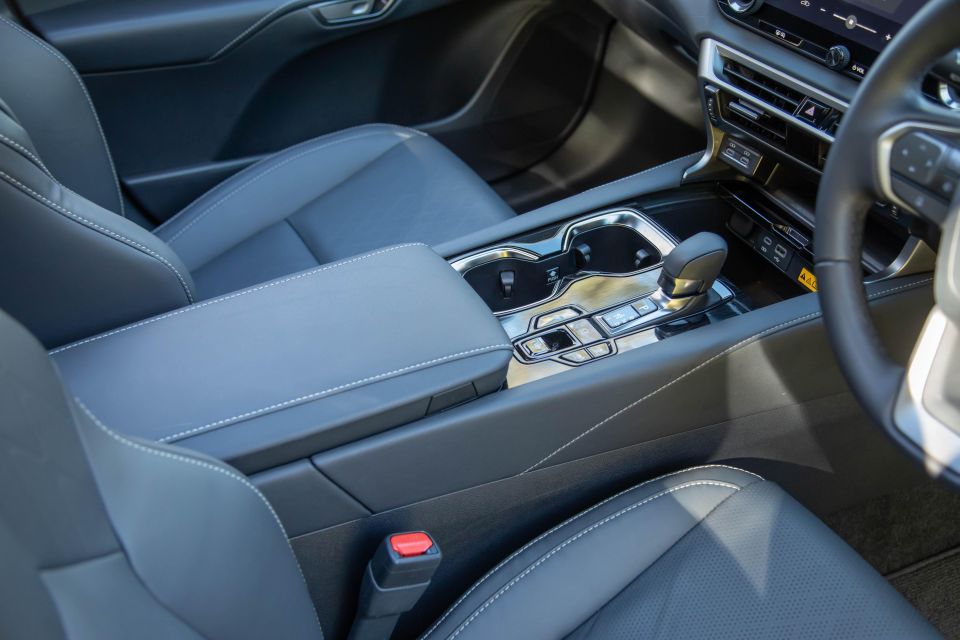
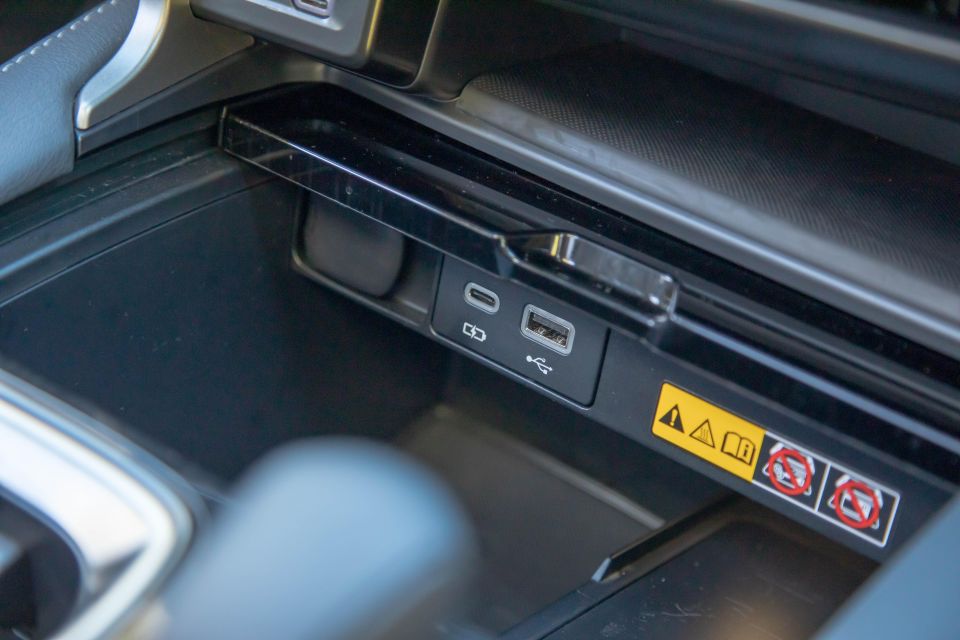
Honestly, this setup is a bit of a concentration drain, and I found myself looking at the head-up display a lot during my week with the car as I tried to learn the controls. Not once did “this is so easy” cross my mind. The controls can be confusing and the buttons are easy to bump, too.
The door handles are another element that offers some “oooh why did they do it that way?” factor. They are electrically-triggered push-button controls. They are an interesting component, but cause no end of confusion for the uninitiated. At least the doors are very pleasing in the way the trigger actuates the opening, and the solid ‘thunk’ is nice, too.
As for storage, the expected elements are there, with a pair of cup holders (including a clever height-adjustable bottom section), a wireless phone charging pad, storage nooks, a centre console bin with a lid that can be opened towards or away from the driver, and big door pockets with bottle holders.
All the requisite charging options are available, including USB-A (x 1) and USB-C (x 3) points for front-seaters, while the back seat also gets a pair of USB-C ports.
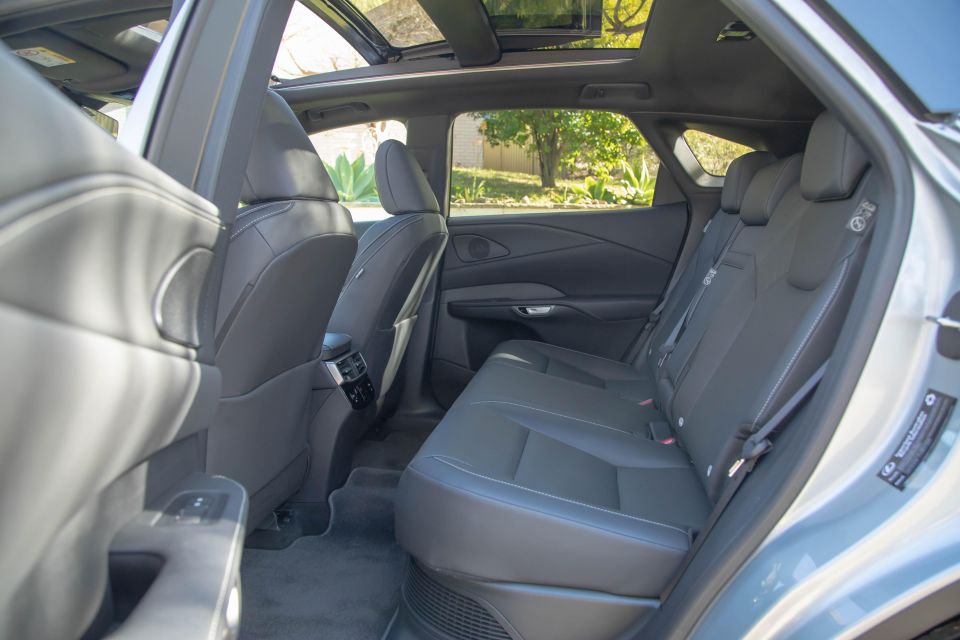
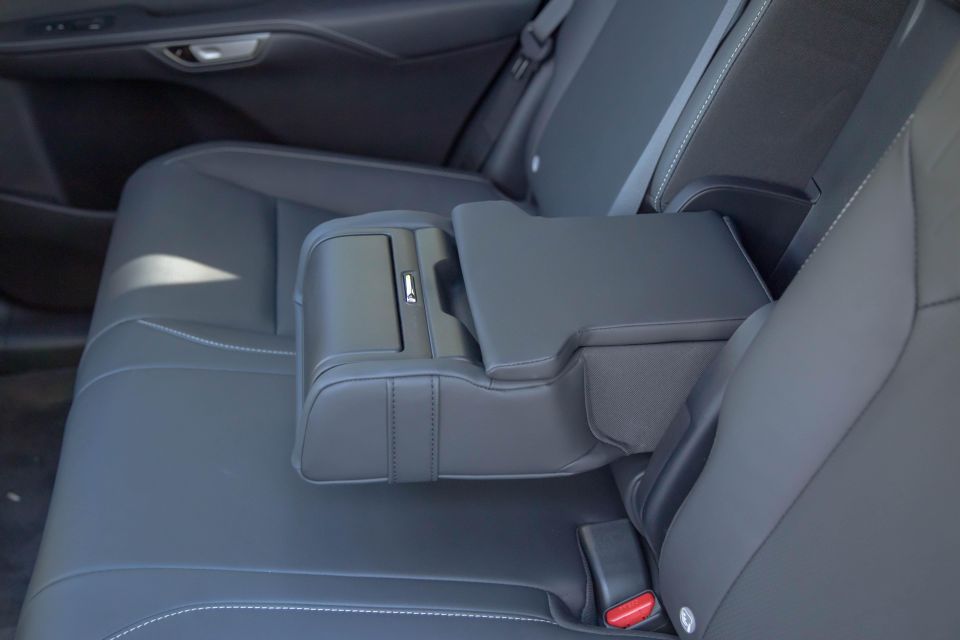
The rear is a pretty accommodating space, with directional air vents, bottle holders in the doors, a flip-down armrest with cup holders and a storage box, and map pockets on the seat backs. There is also a third climate zone for rear-seat occupants in this spec.
Adult occupant space is very good in the back seat of the RX. I had easily enough space to sit behind my own 182cm/6’0” driving position.
There’s ample headroom, leg room, knee space and toe room (unless you have big feet and stretch your legs right out). There’s also ample width to the second row, so three adults across the back is doable, just note that the middle-seat rider will have a bit less leg room thanks to the centre console intrusion.
And yes, I’ve seen quite a few new-gen RXs as taxis. I don’t know whether I’d want to spend $100,000 of my money on the same car that taxi drivers are using, but it shows the practicality on offer.
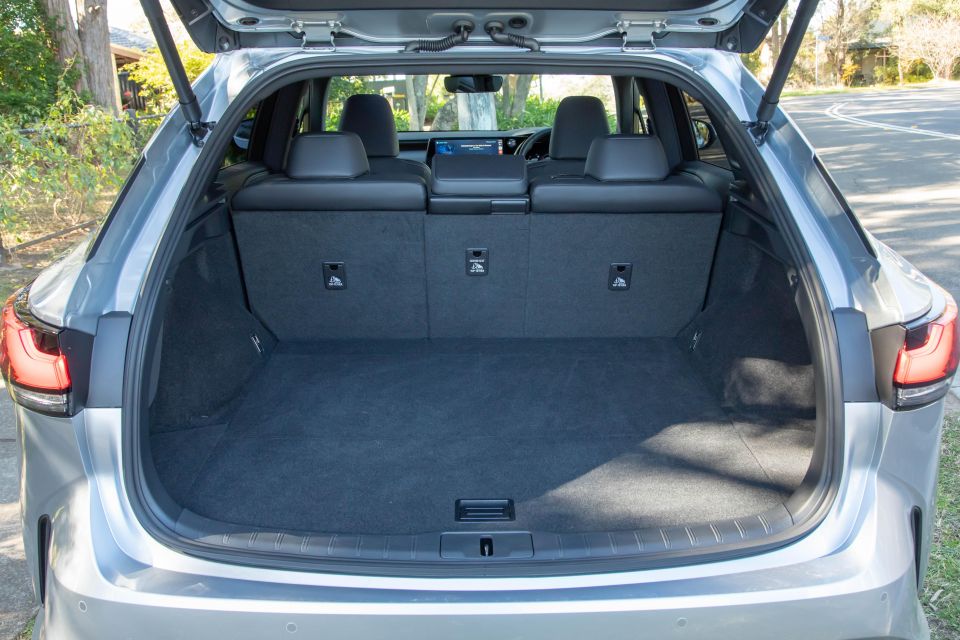
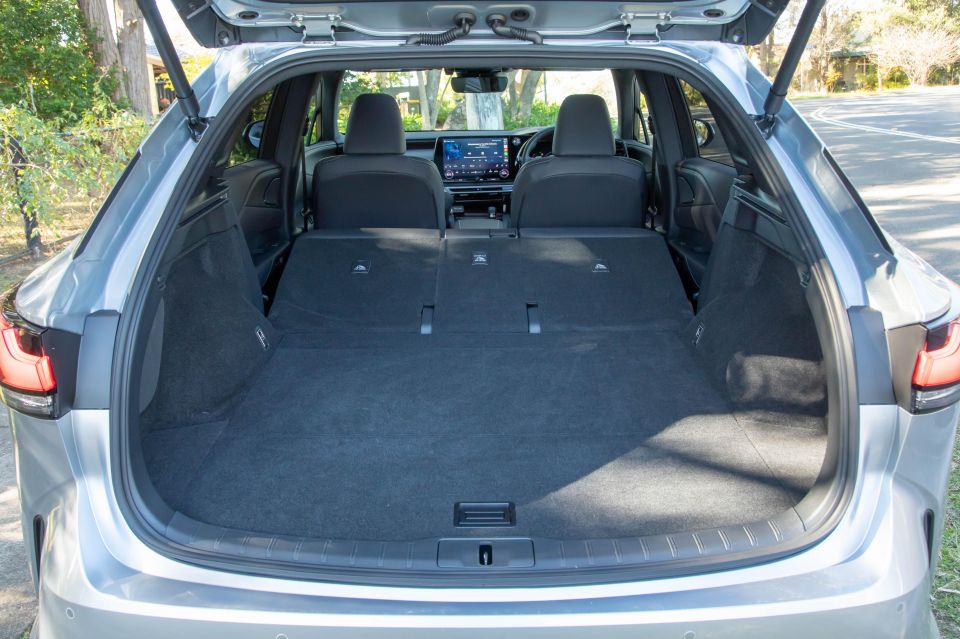
Parents will be happy to know there are outboard ISOFIX points and three top-tether points as well.
In the boot, there’s a pretty good amount of space on offer, with Lexus quoting 612 litres of cargo capacity. The Luxury grade doesn’t get a spare wheel, however – it comes with a tyre repair kit.
The underfloor section houses that kit, plus an emergency triangle and some additional storage.
This version of the Lexus RX comes with a miserly powertrain – a 2.5-litre four-cylinder petrol-electric hybrid setup.
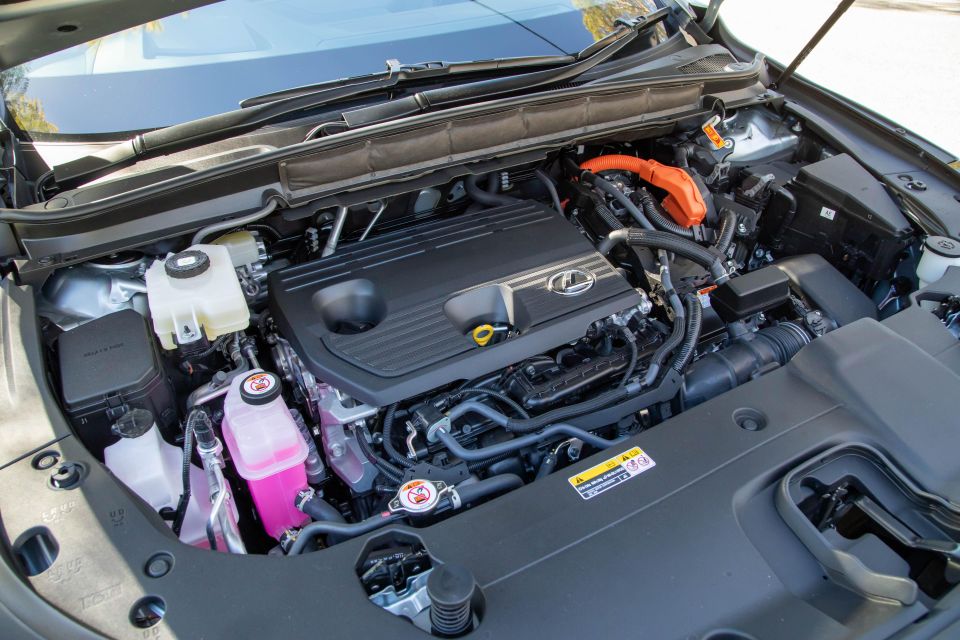
Maximum combined power output is 184kW, and like Toyota, Lexus doesn’t offer a combined torque output.
The engine runs on the Atkinson cycle, and uses an eCVT automatic transmission to channel grunt where it’s needed. Unlike some newer Toyota models, though, the battery used in this Lexus is a nickel-metal hydride unit.
As mentioned, there’s the choice of 2WD (front-wheel drive) or E-Four (all-wheel drive), which adds an electric motor to the rear axle.
I remember driving the last RX at the launch of the final facelift and thinking ‘this is just fine for people who want a luxurious driving experience, but don’t care about fun factor’.
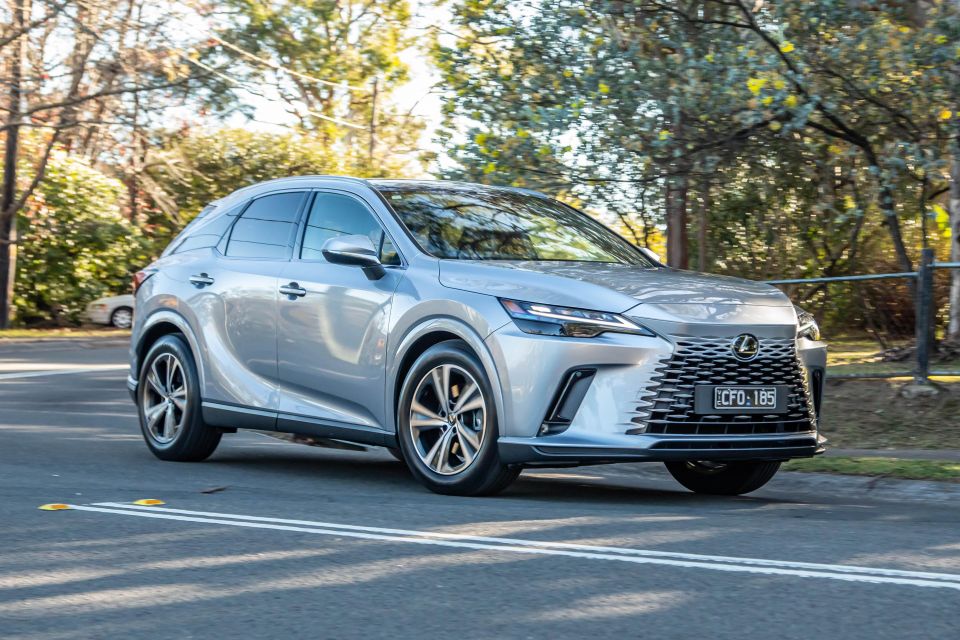
The same thought occurred to me after driving this new-gen RX, which is even more luxurious and comfortable than the last one, and even a bit more enjoyable. But still, it’s not a car you find yourself itching to drive again and again.
That could be the target market for this type of luxury SUV from this luxury brand. And that is 100 per cent, totally fine – I just think that if I was spending this kind of money on an SUV, I’d want it to be a bit more rewarding and enticing to drive.
Look, the hybrid powertrain is really good. The 2.5-litre petrol engine will kick to life when required, and at idle and low speeds is when you notice it most.
But for the most part, the hybrid system is always dipping back into the EV battery reserves in its attempts to make progress as efficiently as possible.
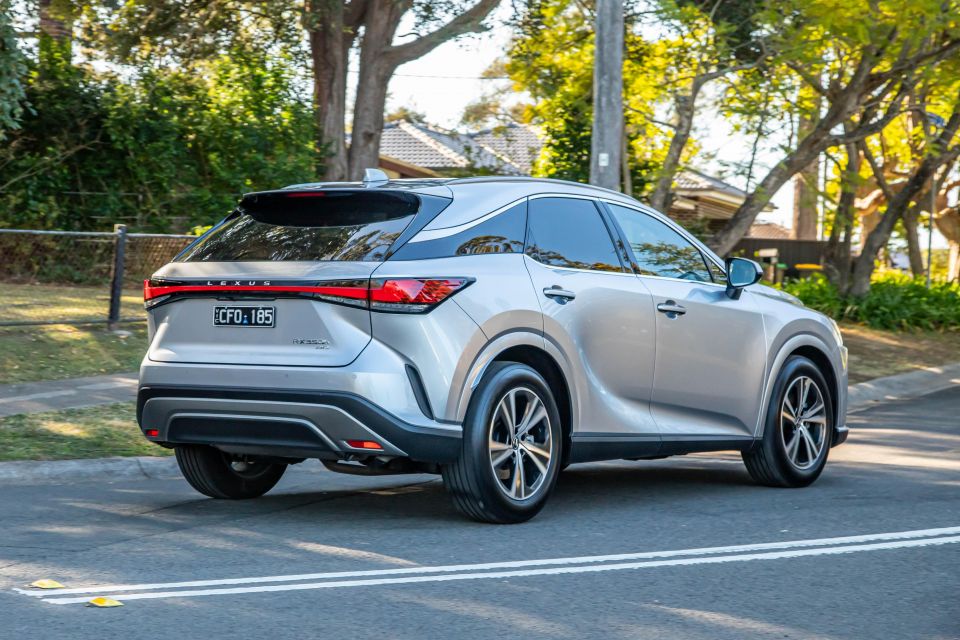
It is also luxurious as a result, with a near-silent drive experience in some situations. There’s ample urge available as well, and when you really thump the throttle you can get from A to B pretty swiftly.
The chassis setup errs towards comfort, as it should, with a decent quality of ride comfort on offer in nearly all situations – though I noted a bit of lumpiness over the sharper-edged bumps in urban driving.
A bit of body roll to contend with in the twisty bits too, but I didn’t go out of my way to push this car to its limits. It’s not that kind of car.
The steering is also nicely predictable and weighted well, too, with a responsive action and easy-to-guess behaviour in all situations.

Braking is maybe something you’ll have to get accustomed to if you’re new to hybrid driving, as there’s a bit of a different feel to the pedal than in non-hybrid models thanks to the regen braking system. It’s better than in the last RX, though.
And while it is all-wheel drive, the chassis is set up to be front-wheel drive primarily, with the rear axle only kicking to action if and when required. Even so, I noted a few instances where the front tyres would spin and scramble for traction at low speeds, even in dry conditions.
All told, it’s a good luxury SUV drive, and a very Lexus-like experience – offering comfortable commuting and easy driving. If that’s what you’re after, this will tick the box for you. If you want something more exciting, there are numerous other choices you could make.
You don’t really get “base model” vibes from the standard equipment list, but nor should you at this kind of money.


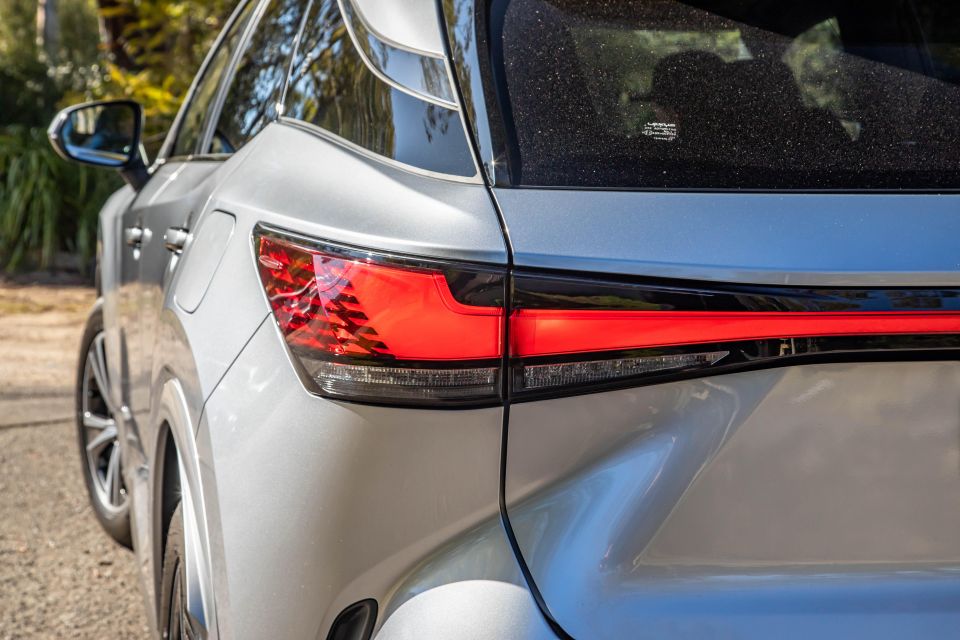
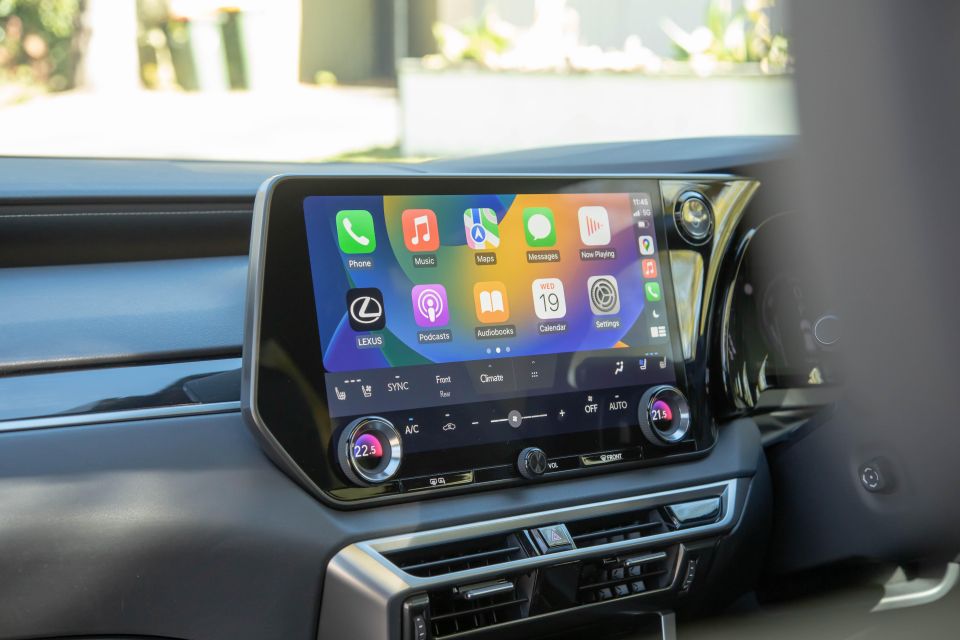
RX 350h Luxury highlights:
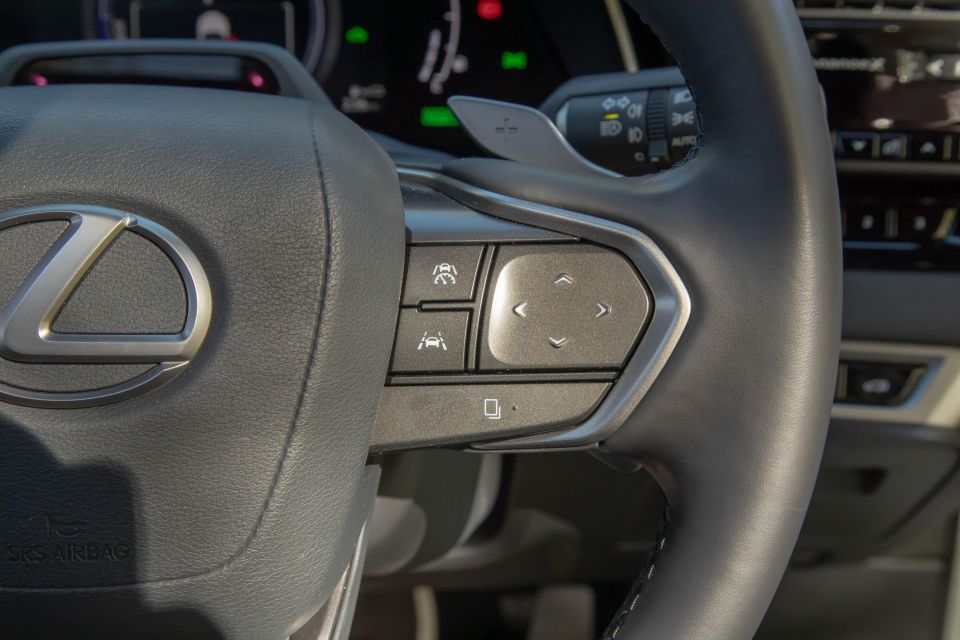
Where expert car reviews meet expert car buying – CarExpert gives you trusted advice, personalised service and real savings on your next new car.
Enhancement Pack ($5500) adds:
I could do without those annoying touch-controls on the steering wheel (difficult to use correctly, easy to use incorrectly), but otherwise, the step up to Enhancement Pack levels of gear seems entirely worthwhile.
he Lexus RX has achieved the maximum five-star ANCAP safety rating based on 2022 testing protocols.
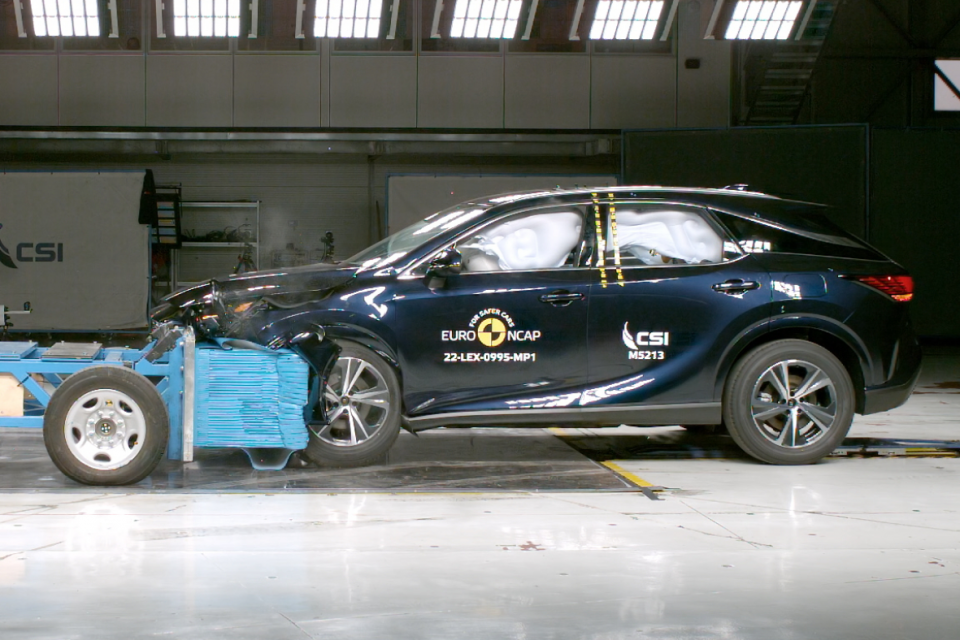
For those keen on a score breakdown, its adult occupant protection rating was 90 per cent, its child occupant protection rating was 89 per cent, its vulnerable road user protection rating was an ANCAP-record-high 89 per cent, and its safety assist rating was 93 per cent.
Standard safety features include:

RX Sports Luxury adds:
It all looks pretty good on paper, but I think Lexus should have fit the RX with a surround-view camera as standard.
This isn’t an easy car to see out of – it’s a large SUV with lots of emphasis on curvy lines – and a panoramic camera system is available on more expensive models.
Let’s talk fuel use first.

The official combined cycle figure for the RX 350h AWD is 5.4 litres per 100km, which is exceptional for a vehicle that’s more than 4.9 metres long and weighs 2005kg (kerb).
On my test, which covered a week of driving in mixed conditions including urban, highway, and freeway motoring, I saw a return of 6.3L/100km. Okay, but not as enticing as the sticker may have suggested it should be.
As for ongoing ownership considerations, the brand backs the RX with a five-year, unlimited-kilometre warranty, and the battery warranty is identical – but can extend by up to five additional years (10-year/unlimited km) if the car is serviced/checked by Lexus.
There’s a five-year/75,000km capped-price servicing plan available, with maintenance due every 12 months/15,000km. However, the service cost situation is on the high side, with each of the first five visits costing $695.
Roadside assistance is included as part of the Lexus Encore program, which spans three years. That also allows owners to have their car collected and returned for servicing, as well as offering owners access to a loan car if their vehicle is out of action.
Buy your new car without the stress. It's fast, simple and completely free.

Great service from Travis and team, second time I have used this business would not hesitate to recommend them to anyone
Craig C.
Purchased a Ford Ranger in Sunshine Coast, QLD
CarExpert helped Craig save $7,224 on his Ford Ranger, now let us save you on your next new car.
Get your BEST priceThe Lexus RX 350h Luxury with Enhancement Pack seems like money well spent if you want a plush, comfortable and efficient luxury SUV with a decent amount of space and heaps of standard inclusions.
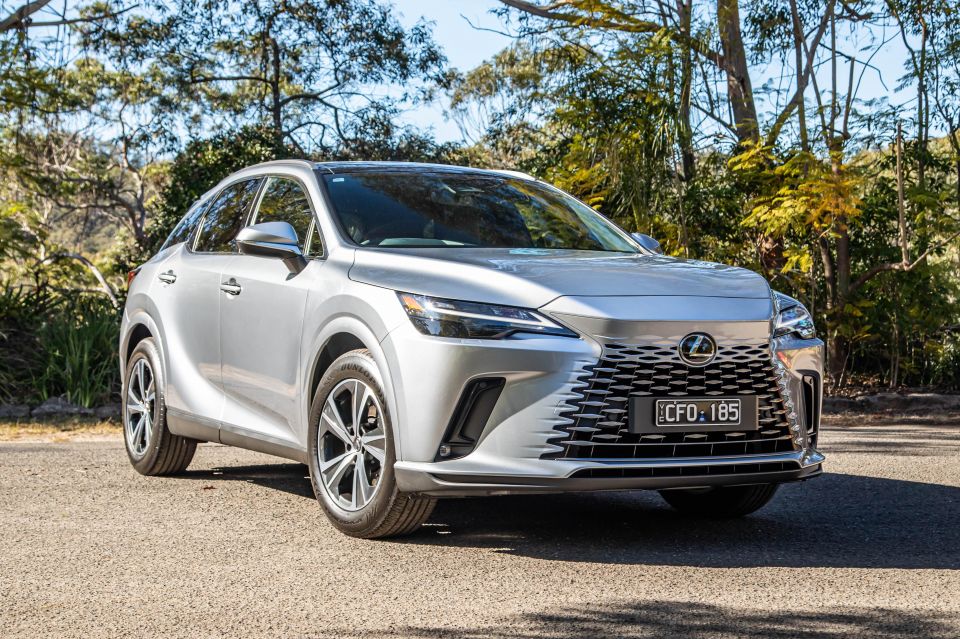
It’s going to suit buyers who want a predictable and polished alternative to the other luxury brands out there. But as I found, it might not appeal to those who want something that’s exciting to drive.
Click the images for the full gallery
MORE: Everything Lexus RX
Where expert car reviews meet expert car buying – CarExpert gives you trusted advice, personalised service and real savings on your next new car.
Matt has more than a decade of experience in automotive journalism, and loves exploring the pros and cons of new cars, delving into deep-dive industry stories, and going for a drive just for the fun of it.


William Stopford
3 Days Ago
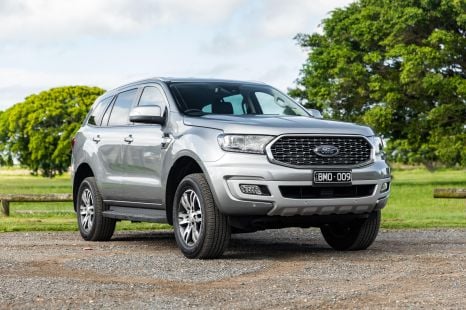

William Stopford
5 Days Ago
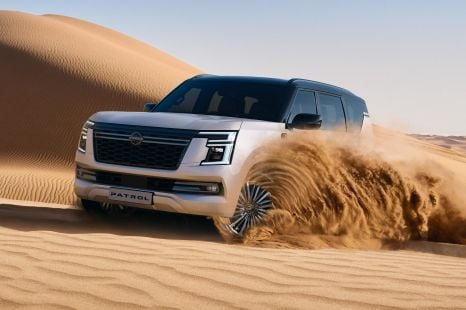

James Wong
8 Days Ago


Derek Fung
12 Days Ago
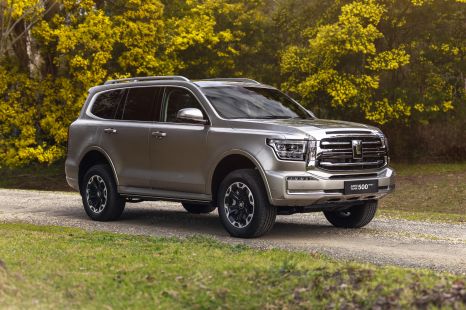

William Stopford
14 Days Ago


William Stopford
20 Days Ago